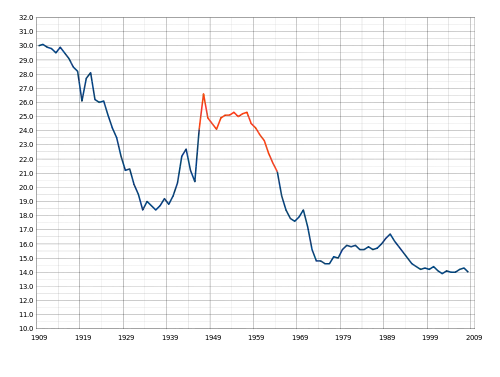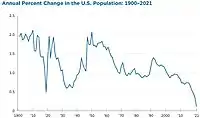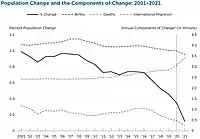Aging of the United States
The United States birth rate has gone down naturally throughout the country's history. This trend has led some demographers to speculate that the United States could end up with an aging and shrinking population and workforce, especially because many developed countries around the world have already been impacted from this trend. Other demographers have argued that population aging in the United States could be solved with policy reforms, or that it could have a positive impact on the country.



History
The birth rate in the United States has declined steadily since the beginning of the 19th century, when the average person had as many as seven children.[1] In a 1905 speech, President Theodore Roosevelt criticized Americans for having fewer children, and described the declining birth rate as a "race suicide" among Americans,[2] quoting eugenicist Edward Alsworth Ross.[3][4] In the 1930s, the Great Depression caused a substantial decrease in the birth rate, but this trend was reversed in the subsequent Baby Boomer generation.[5]
More recently, though, the COVID-19 pandemic caused fertility to decline further,[5][6] while also increasing the death rate in the country.[7] At the same time, many women are choosing to have children later in life. This trend could cause the total population of the country to age significantly in the future.[6]
In the modern world, it has become common for developed countries to fall below the replacement level of births or see population decline. Many of these countries have tried to launch government initiatives to combat this trend, including large cash incentives for having more children. The trend of population decrease has been especially notable in Japan, where the population has grown smaller and the average age has risen for much of the 21st century.[8]
Causes
Population aging in the US is driven by a variety of factors, including increased access to birth control, changing societal attitudes, and lower fertility among modern Americans.[9] Another major cause is the fact that the Baby boomer generation is getting older, adding a large group of older Americans to the population and causing the median age to move up.[10] COVID-19 is also thought to have led to a large decrease in fertility, since many couples decided to wait until the end of the pandemic to have children. There is also evidence that women are choosing to give birth at a later age, which could lead to a temporary drop in population increase.[11]
Some of the birth rate decline may also have come from a decrease in unintentional pregnancy, especially in the context of the teenage pregnancy rate.[11] At the same time, though, national surveys have shown that most Americans would prefer to have more children, which suggests that problems with financial stability and work-life balance may be a more underlying cause.[12]
Finally, a further factor contributing to an aging workforce is the fact that employment rates among older workers are increasing. The rate of people who continue working after they are 65 is relatively high in the US, when compared to other developed countries. For example, in 2011, 16.7% among people aged 65 and over and 29.9% among 65–69 were employed in the US.[13]
Impacts
By 2030, 20% of Americans are predicted to be past the age of retirement, which could pose a burden to the healthcare system. While the population of the country is predicted to increase for several more decades, the average age will likely continue to move higher as well. Older and retired people tend to need more health services, which must be provided by their younger counterparts, so some demographers have theorized that this could have a negative impact on the country.[7] Population aging could create an especially large demand for services like nursing homes and caregiving that is unable to be met by the younger generation,[7] while also exacerbating economic inequality by increasing the importance of family inheritance.[14] An overall decrease in the population could shrink the economy by reducing the demand for basic goods like real estate.[15]
Economy
Due to a declining labor participation rate, there is expected to be a shortage of workers in the U.S. workforce. Projections show that the demand for labor needed now is not being fulfilled, and the gap between labor needed and labor available will continue to expand over the future.[16][17] Owing to the differences in population size between the Baby Boomers and the following younger generations, there has been negative growth in the working age population.[16][17] The baby "busters", also known as generation X, are not as plentiful as the baby boomer generation. They are spending more time educating themselves and training and are entering the workforce at a later age. Therefore, there are fewer and fewer entering the workforce in their early twenties. Baby boomers retiring, means fewer working people and reduces productivity rates in the workforce. The workforce is also losing those skilled enough to do the jobs we have now. A loss in skilled and capable workers has made it harder for employers to recruit new staff.[18] The retirement of members of the aging workforce could possibly result in the shortage of skilled labor in the future.[19][20] A majority of experienced utility workers and hospital caregivers, for example, will be eligible for retirement.[20]
Additionally, a shrinking birth rate could exacerbate economic inequality by increasing the importance of family inheritance,[14] while an overall decrease in the population could shrink the economy by reducing the demand for basic goods like real estate.[15]
Social security benefits
The U.S. federal social security system functions by taxing large numbers of young workers to support smaller numbers of older recipients.[20] A smaller workforce, coupled with increased numbers of longer-living elderly, can deplete the social security system. The Social Security Administration estimates that the old age dependency ratio (people ages 65+ divided by people ages 20–64) in 2080 will be over 40%, compared to the 20% old age dependency ratio in 2005.[20] Increasing life expectancies of the older population will result in decreases in Social Security Benefits and devalues private and public pension programs.[20][21] The elimination of programs that give funds to older people, such as social security and Medicare, may cause adults to delay retirement and to continue working.[22]
Occupational safety
Because of the many older adults opting to remain in the U.S. workforce, many studies have been done to investigate whether the older workers are at greater risk of occupational injury than their younger counterparts. Due to the physical declines associated with aging, older adults tend to exhibit losses in eyesight, hearing and physical strength.[20] Data shows that older adults have low overall injury rates compared to all age groups, but are more likely to suffer from fatal and more severe occupational injuries.[20][23] Of all fatal occupational injuries in 2005, older workers accounted for 26.4%, despite only comprising 16.4% of the workforce at the time.[23] Age increases in fatality rates in occupational injury are more pronounced for workers over the age of 65.[23] The return to work for older workers is also extended; older workers experience a greater median number of lost work days and longer recovery times than younger workers.[23] Some common occupational injuries and illnesses for older workers include arthritis[22] and fractures.[24] Among older workers, hip fractures are a large concern, given the severity of these injuries.[24]
Health care
By 2030, 20% of Americans are predicted to be past the age of retirement, which could pose a burden to the healthcare system. Older and retired people tend to need more health services, which must be provided by their younger counterparts, so some demographers have theorized that this could have a negative impact on the country.[7] Older adults will also have to deal with more chronic diseases; older adults who have worked in the construction industry have shown high rates of chronic diseases.[21][25] Experts suggest that the number of geriatricians will have to triple to meet the demands of the rising elderly.[26] There is expected to be a similarly increased demand in other healthcare professionals, such as nurses, occupational therapists, physical therapists and dentists.[26] In addition, there is expected to be an increasing demand over common geriatric care consumption needs, such as medications, joint replacements and cardiovascular operations.[26]
Society
Population aging can potentially change American society as a whole. Many companies use an antiquated system, in which older, tenured workers get raises and benefits over time, eventually hitting retirement.[27] With larger numbers of older workers in the workforce, this model is possibly unsustainable. In addition, perceptions of older adults in society will change, as the elderly are living longer lives and more active than before. A University of Alabama at Birmingham article stated that society faces a cultural ageism in the perceptions about older adults, which will change over time.[26]
Proposed solutions
A number of potential strategies have been proposed to combat the potential problems caused by an aging population. To deal with the increased demand that could be placed on the healthcare system, telehealth and virtual health monitoring has arisen as a way to help support a larger population of older adults.[28] Alternatively, some people have advocated for offering more paid parental leave and child care, thereby encouraging people to have more children.[15] These policies have already been employed in other areas of the world, and in the Czech Republic they successfully increased the rate of fertility.[29]
Some have argued that reduced immigration will have a larger impact on population growth than the declining birth rate.[30] Immigration has historically been a source of growth for the US, and some have suggested that it could slow or reverse the trend of population aging or decline.[31] However, studies have shown that immigrants from countries with high-fertility rates often have fewer children when they immigrate to a country where small families are the norm.[32] It has also been shown that low-birth rates[33] and sudden increases in immigration often lead to increased feelings of populism and xenophobia.[34] Arguments in favor of increasing immigration to combat declining population levels have sparked outcry from far-right nationalist groups in the United States and some European countries.[35]
Other perspectives
Other demographers have suggested that a declining birth rate may have net positive effects on the country.[36] One theory is that the abrupt decline in births seems to have been caused by COVID-19, which could mean that women who postponed having children during the pandemic will still do so eventually.[37] In the past, events like the Great Recession of 2008 created a temporary decrease in the birth rate, but the trend was eventually reversed.[38] Additionally, there is some research supporting the idea that in well-educated countries, it might actually benefit the population to have a birth rate below replacement levels.[39]
Many environmentalists see this trend more optimistically because it could help combat the perceived problem of overpopulation. The world population is expected to reach almost 10 billion by the year 2050, which could pose a burden to Earth's natural resources.[40] Having fewer children has been shown to be an effective way to reduce environmental impact through reduced carbon footprint and higher populations could increase the effects of climate change in the future.[41]
References
- "United States: fertility rate 1800–2020". Statista. Archived from the original on 2021-07-09. Retrieved 2021-07-05.
- "II. On American Motherhood by Theodore Roosevelt. America: III. (1861–1905). Vol. X. Bryan, William Jennings, ed. 1906. The World's Famous Orations". www.bartleby.com. Archived from the original on 2004-01-08. Retrieved 2021-07-28.
- Dyer, Thomas G. (1992-07-01). Theodore Roosevelt and the Idea of Race. LSU Press. p. 15. ISBN 978-0-8071-1808-5. Archived from the original on 2021-08-11. Retrieved 2021-08-02.
- Lovett, Laura L. (2009-11-30). Conceiving the Future: Pronatalism, Reproduction, and the Family in the United States, 1890–1938. Univ of North Carolina Press. pp. 91–92. ISBN 978-0-8078-6810-2. Archived from the original on 2021-08-11. Retrieved 2021-08-02.
- "What's behind the falling U.S. birthrate?". University of Michigan News. 2021-05-13. Archived from the original on 2021-07-09. Retrieved 2021-07-06.
- Mendez, Rich (2021-05-05). "U.S. birth and fertility rates in 2020 dropped to another record low, CDC says". CNBC. Archived from the original on 2021-07-07. Retrieved 2021-07-06.
- Meola, Andrew. "The aging US population is creating many problems—especially regarding elderly healthcare issues". Business Insider. Archived from the original on 2021-07-09. Retrieved 2021-07-08.
- "The U.S. birthrate is falling. Here's how other countries have tried to persuade people to have more children". Washington Post. ISSN 0190-8286. Archived from the original on 2021-08-11. Retrieved 2021-07-07.
- Nargund, G. (2009). "Declining birth rate in Developed Countries: A radical policy re-think is required". Facts, Views & Vision in ObGyn. 1 (3): 191–193. ISSN 2032-0418. PMC 4255510. PMID 25489464.
- Bureau, US Census. "The Graying of America: More Older Adults Than Kids by 2035". The United States Census Bureau. Archived from the original on 2021-06-30. Retrieved 2021-07-07.
- "With a potential 'baby bust' on the horizon, key facts about fertility in the U.S. before the pandemic". Pew Research Center. Archived from the original on 2021-07-07. Retrieved 2021-07-07.
- Ponnuru, Ramesh (May 11, 2021). "Want More American Babies? Make the U.S. More Livable". Bloomberg news. Archived from the original on 2021-07-09. Retrieved 2021-07-07.
- "Data and Statistics – Productive Aging and Work | NIOSH | CDC". www.cdc.gov. 2020-02-21. Archived from the original on 2021-08-11. Retrieved 2021-08-01.
- Stone, Lyman (February 11, 2021). "Escaping the Parent Trap". AEI. Archived from the original on July 9, 2021. Retrieved July 8, 2021.
- Murray, Stephanie H. (2021-06-09). "How Low Can America's Birth Rate Go Before It's A Problem?". FiveThirtyEight. Archived from the original on 2021-07-10. Retrieved 2021-07-09.
- Howard, John (March 23, 2011), "The Future Workforce and Applied Ergonomics", 14th Annual Applied Ergonomics conference & Expo, Orlando, Florida
- Schill, Anita L. (May 18, 2011), The Future of Work & the Aging Workforce, Electricity Safety Summit, Washington, District of Columbia
- Woolley, Josephine (2006). Ageism in the Era of Workforce Shrinkage. Greenleaf Publishing (IngentaConnect). pp. 113–129. ISBN 9781909493605.
- Chosewood, L. Casey (July 19, 2012). "CDC – NIOSH Science Blog – Safer and Healthier at Any Age: Strategies for an Aging Workforce". National Institute for Occupational Safety and Health. Archived from the original on 2012-07-28. Retrieved 2012-07-25.
- Silverstein, Michael (2008). "Meeting the challenges of an aging workforce". American Journal of Industrial Medicine. 51 (4): 269–280. doi:10.1002/ajim.20569. PMID 18271000.
- Schwatka, Natalie V.; Butler, Lesley M.; Rosecrance, John R. (2012), "An aging workforce and injury in the construction industry", Epidemiologic Reviews, 34: 156–167, doi:10.1093/epirev/mxr020, PMC 7735369, PMID 22173940
- Caban-Martinez, Alberto J.; Lee, David J.; Fleming, Lora E.; Tancredi, Daniel J.; Arheart, Kristopher L.; LeBlanc, William G.; McCollister, Kathryn E.; Christ, Sharon L.; Louie, Grant H.; Muennig, Peter A. (2011), "Arthritis, occupational class, and the aging US workforce", American Journal of Public Health, 101 (9): 1729–1734, doi:10.2105/ajph.2011.300173, PMC 3154222, PMID 21778483
- Grosch, James W.; Pransky, Glenn S. (2010), "Safety and Health Issues for an Aging Workforce", in Czaja, Sara J.; Sharit, Joseph (eds.), Aging and Work: Issues and Implications in a Changing Landscape, Baltimore, Maryland: Johns Hopkins University Press
- Centers for Disease Control and Prevention (2011), "Nonfatal occupational injuries and illnesses among older workers – United States, 2009", Morbidity and Mortality Weekly Report, 60 (16): 503–508, PMID 21527887
- Dong, Xiuwen S.; Wang, Xuanwen; Daw, Christina; Ringen, Knut (2011), "Chronic disease and functional limitations among older construction workers in the United States: a 10-year follow-up study", Journal of Occupational and Environmental Medicine, 53 (4): 372–380, doi:10.1097/jom.0b013e3182122286, PMID 21407096, S2CID 13763613
- Bob Shepard, The University of Alabama at Birmingham (December 30, 2010). "Beware the "silver tsunami" – the boomers turn 65 in 2011". The University of Alabama at Birmingham. Archived from the original on October 26, 2012. Retrieved 2012-07-25.
- The Economist (February 4, 2010). "Schumpeter: The silver tsunami". The Economist. Archived from the original on 2012-10-28. Retrieved 2012-07-25.
- Meola, Andrew. "The aging US population is creating many problems—especially regarding elderly healthcare issues". Business Insider. Archived from the original on 2021-07-09. Retrieved 2021-07-09.
- Pinsker, Joe (2021-07-06). "The 2 Ways to Raise a Country's Birth Rate". The Atlantic. Archived from the original on 2021-07-08. Retrieved 2021-07-09.
- Raftery, Adrian. "The dip in the US birthrate isn't a crisis, but the fall in immigration may be". The Conversation. Archived from the original on 2021-07-17. Retrieved 2021-07-15.
- Feffer •, John (2021-05-07). "Immigration Is the Solution for the Falling US Birth Rate". Fair Observer. Archived from the original on 2021-07-10. Retrieved 2021-07-10.
- MacNamara, Trent (2019-03-26). "Liberal Societies Have Dangerously Low Birth Rates". The Atlantic. Archived from the original on 2021-07-10. Retrieved 2021-07-10.
- Khazan, Olga (2018-05-26). "A Surprising Reason to Worry About Low Birth Rates". The Atlantic. Archived from the original on 2021-07-15. Retrieved 2021-07-15.
- Stone, Lyman (2017-11-10). "The US needs more babies, more immigrants, and more integration". Vox. Archived from the original on 2021-04-24. Retrieved 2021-07-15.
- "Can Better Policies Solve the West's Population Crisis?". Time. Archived from the original on 2021-07-15. Retrieved 2021-07-15.
- Oliveira, Alexandra (2021-06-04). "No, Henny-Penny, America's demographic sky is not falling". TheHill. Archived from the original on 2021-07-15. Retrieved 2021-07-15.
- Root, Leslie. "Why We Shouldn't Worry About Falling Birthrates". The Washington Post.
- "Is U.S. fertility at an all-time low? Two of three measures point to yes". Pew Research Center. Archived from the original on 2021-07-11. Retrieved 2021-07-10.
- Striessnig, Erich; Lutz, Wolfgang (2013-08-01). "Can below-replacement fertility be desirable?". Empirica. 40 (3): 409–425. doi:10.1007/s10663-013-9213-3. ISSN 1573-6911. S2CID 154120884. Archived from the original on 2021-08-11. Retrieved 2021-07-10.
- "Birth rates are falling but overpopulation still a concern". Archived from the original on 2021-07-10. Retrieved 2021-07-10.
- Davis, Adam (June 2019). "The Problem of Overpopulation: Proenvironmental Concerns and Behavior Predict Reproductive Attitudes". Environmentalism and Reproductive Attitudes.